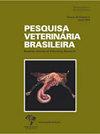Goiás自由放养的水禽爆发C型肉毒杆菌中毒
IF 0.8
4区 农林科学
Q3 VETERINARY SCIENCES
引用次数: 0
摘要
摘要:肉毒杆菌中毒通常是由摄入肉毒梭菌产生的神经毒素引起的一种致命疾病。本研究描述了在巴西Quirinópolis, Goiás城市公园中自由生活的水禽中爆发的C型肉毒杆菌中毒的流行病学,临床和实验室方面。在大约80只水禽中,包括鸭(Cairina moschata)、鸭(Anas platyrhynchos)和鹅(Anser cygnoides)在内的30只鸟在10天内死亡。其中,6只鸟表现出骨盆肢体、眼睑、颈部和翅膀的弛缓性麻痹的迹象。为确认肉毒杆菌中毒的嫌疑,分析了4个湖水样本、2个家禽食用饲料样本,以及2只出现临床症状后死亡的鸭的血清、肠内容物、胃内容物和肝脏组织样本。利用生物测定和同源抗毒素在小鼠体内的中和,可以在水样和其中一只死鸭的肠道内容物中检测到C型肉毒杆菌毒素的存在。此外,采用聚合酶链反应法在湖水中鉴定出C型肉毒杆菌。根据临床表现和实验室结果,诊断为C型肉毒杆菌中毒,可能由湖水传播。本文章由计算机程序翻译,如有差异,请以英文原文为准。
Type C botulism outbreak in free-ranging waterfowl in Goiás
ABSTRACT: Botulism is generally a fatal disease caused by ingestion of neurotoxins produced by Clostridium botulinum. The present study describes the epidemiological, clinical, and laboratory aspects of a type C botulism outbreak in free-living aquatic birds residing in an urban park in Quirinópolis, Goiás, Brazil. Among a population of approximately 80 waterfowl, a total of 30 birds, including ducks (Cairina moschata), teals (Anas platyrhynchos), and geese (Anser cygnoides), died within 10 days. Of these, six birds showed signs of flaccid paralysis of the pelvic limbs, eyelids, neck, and wings. To confirm the suspicion of botulism, four lake water samples, two samples of the feed consumed by the birds, and samples of serum, intestinal content, stomach content, and liver tissue from two teals that died after presenting clinical signs were analyzed. Using bioassay and neutralization with homologous antitoxin in mice, it was possible to detect the presence of botulinum toxin type C in a water sample and in the intestinal content of one of the necropsied teals. Additionally, the presence of C. botulinum type C was identified in the lake water using polymerase chain reaction. Based on the clinical signs and laboratory results, a diagnosis of botulism caused by botulinum toxin type C was confirmed with probable transmission by lake water.
求助全文
通过发布文献求助,成功后即可免费获取论文全文。
去求助
来源期刊

Pesquisa Veterinaria Brasileira
农林科学-兽医学
CiteScore
1.30
自引率
16.70%
发文量
41
审稿时长
9-18 weeks
期刊介绍:
Pesquisa Veterinária Brasileira - Brazilian Journal of Veterinary Research (http://www.pvb.com.br), edited by the Brazilian College of Animal Pathology in partnership with the Brazilian Agricultural Research Organization (Embrapa) and in collaboration with other veterinary scientific associations, publishes original papers on animal diseases and related subjects. Critical review articles should be written in support of original investigation. The editors assume that papers submitted are not being considered for publication in other journals and do not contain material which has already been published. Submitted papers are peer reviewed.
The abbreviated title of Pesquisa Veterinária Brasileira is Pesqui. Vet. Bras.
 求助内容:
求助内容: 应助结果提醒方式:
应助结果提醒方式:


